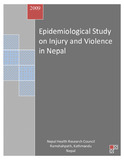Please use this identifier to cite or link to this item:
https://hdl.handle.net/20.500.14356/792Full metadata record
| DC Field | Value | Language |
|---|---|---|
| dc.contributor.author | Nepal Health Research Council (NHRC) | - |
| dc.date.accessioned | 2012-12-28T20:55:22Z | - |
| dc.date.accessioned | 2022-11-08T10:20:45Z | - |
| dc.date.available | 2012-12-28T20:55:22Z | - |
| dc.date.available | 2022-11-08T10:20:45Z | - |
| dc.date.issued | 2009 | - |
| dc.identifier.uri | http://103.69.126.140:8080/handle/20.500.14356/792 | - |
| dc.description.abstract | Introduction: Global Scenario Injury is a major global disease burden for the twenty-first century. Injuries are overlooked as contributors to global inequities in health, yet the long-term disabilities they frequently produce represent a significant burden. Injuries occur as a result of environmental, social, biological, economic, and behavioral factors. Injuries have traditionally been regarded as random, unavoidable “accidents”. Within the last few decades, however, a better understanding of the nature of injuries has changed these old attitudes, and today both unintentional and intentional injuries are viewed as largely preventable events. As a result of this shift in perception, injuries and their health implications have demanded the attention of decision-makers worldwide and injury policy has been firmly placed in the public health arena. | en_US |
| dc.language.iso | en_US | en_US |
| dc.publisher | Nepal Health Research Council | en_US |
| dc.subject | Epidemiological | en_US |
| dc.subject | Injury and Violence | en_US |
| dc.subject | Nepal | en_US |
| dc.title | Epidemiological Study on Injury and Violence in Nepal | en_US |
| dc.type | Technical Report | en_US |
| Appears in Collections: | NHRC Research Report | |
Items in DSpace are protected by copyright, with all rights reserved, unless otherwise indicated.

